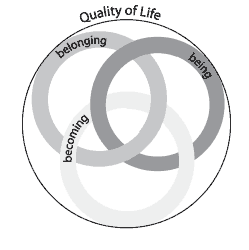 |
The Quality of Life Model |
||||||||||||||||||||||||||||||







|
The Quality of Life model used in research projects carried out by the Quality of Life Research Unit, was developed at the Centre for Health Promotion, University of Toronto. It was the development of this model and a request by the Ontario Ministry of Community and Social Services to carry out Quality of Life research that led to the formation of the Quality of Life Research Unit.  DevelopmentThe Centre for Health Promotion conceptual model is seen as applicable to all persons, with or without developmental disabilities. It was developed on the basis of an analysis of the literature on quality of life and qualitative data we collected in the context of focus groups and in-depth interviews with persons with and without developmental disabilities. Following the preliminary development of the conceptual model, it was tested for relevance and refined by means of rigorous review by adults with and without physical and developmental disabilities, adolescents, and older adults living in the community. In each case, the applicability of these concepts was examined for relevancy for the population, instruments and methods were created, and collection of data carried out. The model is multidimensional and assumes that quality of life is holistic in nature. The Quality of Life Profile was developed to provide a measure that considers both the components and determinants of health and well-being. It draws upon a conceptual model that is consistent with recent definitions of health and health promotion as provided by the World Health Organization. The profile emphasizes individuals' physical, psychological, and spiritual functioning; their connections with their environments; and opportunities for maintaining and enhancing skills. Conceptual FrameworkOur conceptualization defines Quality of Life as: The degree to which a person enjoys the important possibilities of his or her life. Possibilities result from the opportunities and limitations each person has in his/her life and reflect the interaction of personal and environmental factors. Enjoyment has two components: the experience of satisfaction or the possession or achievement of some characteristic, as illustrated by the expression: "She enjoys good health." Our conceptual framework has three life domains, each of which has three sub-domains.
Importance and SatisfactionThe extent of a person's Quality of Life in the areas of Being, Belonging, and Becoming and their sub-domains is determined by two factors: importance and enjoyment. Thus, Quality of Life consists of the relative importance or meaning attached to each particular dimension and the extent of the person's enjoyment with respect to each dimension. In this way quality of life is adapted to the lives of all humans, at any time, and from their individual perspectives. Decision-Making and OpportunitiesThis sensitivity to the specific life situations of individual people also presents a limitation, namely that people may be highly satisfied with the important possibilities of their lives within an environment that is of poor quality. This may result from people being unaware that better quality is possible, or from people being consciously aware that they have to suppress the importance of some possibilities because of their present circumstances. For example, people living in institutions may consider their quality of life to be good because they have had no opportunities to know other possibilities and have no power to effect change in any case. Thus quality of life needs to include the quality of the environment in which the person lives. To address this, we consider that a quality environment is one which:
Thus, a person's perceptions concerning his/her decision making regarding the important possibilities of his/her life and the extent of his/her potential opportunities in the areas encompassed by Being, Belonging, and Becoming are indicated by the Control and Opportunities scores. While these measures are not part of the computation of QOL scores, they provide information by which Quality of Life scores can be interpreted. |
|
|||||||||||||||||||||||||||||
| Quality of Life Research Unit |
|||||||||||||||||||||||||||||||